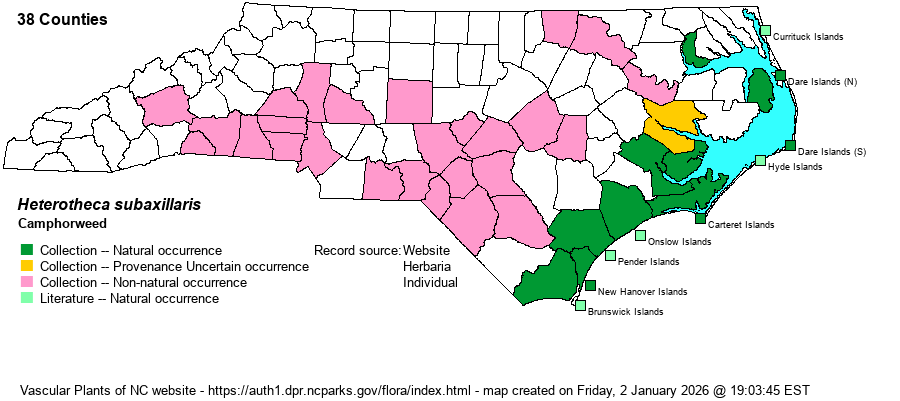| Section 6 » Order Asterales » Family Asteraceae |
Show/Hide Synonym
| taxonName | relationship | relatedTaxonName | relatedTaxonRefText | relComments |
|---|
|
|
| Heterotheca subaxillaris | = | Heterotheca subaxillaris var. subaxillaris | Semple (1983). Key adapted in part from Z and X. [also see Chrysopsis and Pityopsis] | | | Heterotheca subaxillaris | = | Heterotheca subaxillaris var. subaxillaris | Semple (1983). Key adapted in part from Z and X. [also see Chrysopsis and Pityopsis] | | | Heterotheca subaxillaris | < | Heterotheca subaxillaris | Gleason and Cronquist (1991) | | | Heterotheca subaxillaris | < | Heterotheca subaxillaris | Fernald (1950) | | | Heterotheca subaxillaris | < | Heterotheca subaxillaris | Gleason (1952) | | | Heterotheca subaxillaris | < | Heterotheca subaxillaris | Kartesz (1999) | | | Heterotheca subaxillaris | < | Heterotheca subaxillaris | | | | Heterotheca subaxillaris | < | Heterotheca subaxillaris | Radford, Ahles, and Bell (1968) | | | Heterotheca subaxillaris | < | Heterotheca subaxillaris | Small (1933, 1938) | | | Heterotheca subaxillaris | < | Heterotheca subaxillaris | Vascular Flora of the Southeastern States (Cronquist 1980, Isely 1990) | | | Heterotheca subaxillaris | < | Heterotheca subaxillaris | Wunderlin & Hansen Flora of Florida (3) | | | Heterotheca subaxillaris | = | Heterotheca subaxillaris ssp. subaxillaris | Flora of North America (1993b, 1997, 2000, 2002a, 2002b, 2003a, 2004b, 2005, 2006a, 2006b, 2006c, 2007a, 2009, 2010) | | | Heterotheca subaxillaris | = | Heterotheca subaxillaris ssp. subaxillaris | | | | Source: Weakley's Flora |
|
| Author | (Lamarck) Britton & Rusby | |
| Distribution | This species is generally restricted to coastal dunes and other sandy areas near the coast, and it is considered as native to the Atlantic Coast. Farther inland records of "H. subaxillaris" in NC were formerly referred to H. latifolia, but Weakley (2020) merged that species into H. subaxillaris; thus, records away from tidal areas are almost certainly not native. It is found mainly just in the Coastal Plain and Piedmont.
NY south to FL and TX; Mex. Generally native only along and near the coast. | |
| Abundance | It is still quite common to abundant within its narrow coastal range. Farther inland, can be locally numerous, mainly in the southwestern Coastal Plain and Sandhills. | |
| Habitat | Sandy coastal areas (low dunes, sand flats, etc.). How much it extends into sandy disturbances near the coast is blurred by the unclear separation of these two taxa. Farther inland, found in waste plains and other sandy disturbed ground. |
| Phenology | Flowering and fruiting from July to October. | |
| Identification | This is a medium sized species, growing to 2-3 feet tall, often leaning but can be erect; it is quite scabrous on the leaves. It has numerous ovate basal and stem leaves, the lower ones with a stalk. There are numerous yellow heads (both disk and ray florets), in a flat-topped inflorescence. Each flower is about 1.5 inch across. | |
| Taxonomic Comments | The entity known as Heterotheca subaxillaris in RAB (1968) has since been split into the "new" H. subaxillaris, which is native to coastal regions of NC, and H. latifolia, which is a species native to the south-central U.S. and nearby Mexico. This latter species has spread into the southeastern states over the last 100 years, and by the time of RAB (1968) had already been found in much of the southern Piedmont and scattered elsewhere in the state (see the range map in that publication and on the BONAP map). H. latifolia is considered as adventive in NC by Weakley (2018) and thus has an SE state rank. However, Weakley (2020) has merged latifolia into subaxillaris -- thus, "back to the RAB (1968) days!"
| |
| Other Common Name(s) | Dune Camphorweed when this species was split by Weakley (2018). | |
| State Rank | S5 | |
| Global Rank | G5 | |
| State Status | | |
| US Status | | |
| USACE-agcp | | |
| USACE-emp | | |

